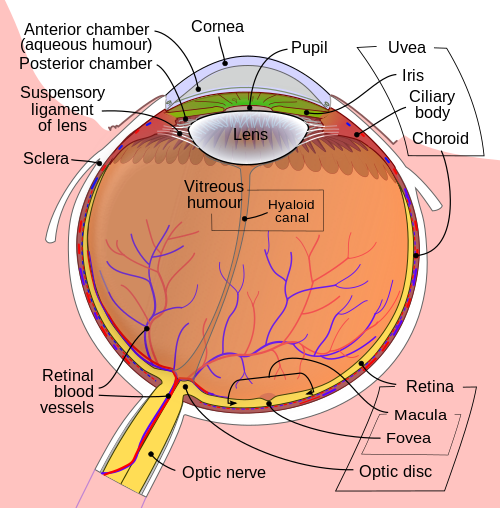What Is Uveitis?
Uveitis means inflammation of the uvea, the inside of the eye, which is made up of three main parts: the iris, the ciliary body and the choroid.
Iritis is inflammation confined to the iris of the eye. Inflammation in the iris is more correctly classified as anterior uveitis because often, there is another part of the front of the eye affected called the ciliary body.
Uveitis can affect one or more of the three parts of the eye; and depending upon where the inflammation occurs, the uveitis is categorized into:
- Anterior uveitis: affecting the front chamber of the eye (the most common form).
- Intermediate uveitis: affecting the middle section of the uvea.
- Posterior uveitis: affecting the rear of the uvea.
- Panuveitis: affecting all three parts of the uvea.

Human eye schema – by Rhcastilhos, via Wikimedia
The majority of adults will experience symptoms such as light sensitivity, which leads them to visit a doctor or eye clinic. However, it is significant to note that many children suffer no symptoms at all until vision is lost. Therefore, the importance of regular visits to an optician or ophthalmologist cannot be stressed enough.
Uveitis can affect anyone of any age. It is a treatable condition, but if left untreated or undertreated it can result in blindness, illustrated by the fact that Uveitis is the third leading cause of preventable blindness worldwide. For this reason, patients are urged to receive treatment from an Ocular Immunologist or uveitis specialist who has advanced training in inflammatory eye disease.
In the UK there are an estimated 9,000 uveitis sufferers, 10% of whom are children. There are many causes of uveitis, from autoimmune diseases to infections, but for 35% to 50% of people no cause is found and the uveitis is said to be idiopathic.
Most sufferers will have uveitis in one eye only and the attack will clear up after two to three months on eye drops. For the really lucky ones, this will be a one and only attack (acute uveitis). For others there will be further attacks of uveitis many months or years apart (recurrent uveitis) and, for a few, the uveitis will recur more regularly, may affect both eyes and may become chronic and complicated, and in some cases sight threatening.
When this happens, uveitis patients are usually tested for an underlying disease. For some, an underlying disease has already been diagnosed before a first attack of uveitis.
A minority will be diagnosed with intermediate, posterior or pan uveitis. These types of uveitis are generally more serious and sight threatening.
If your anterior uveitis becomes chronic and complicated, or you are diagnosed with posterior uveitis, it is important to be treated by a uveitis specialist, or that your treating doctor is being guided by one. You may have to travel to see a specialist, but the inconvenience and cost of this is nothing compared with the cost of lost vision.
If you have one of the more serious or chronic types of uveitis, and you are being treated in a non-specialist eye clinic, asking the following questions will help you determine if the clinic is able to offer you the treatment your uveitis may need after the initial steroid treatment:
- Will I always be treated with steroid?
- Do you treat uveitis with immunosuppressant treatment?
- Will immunosuppressant treatment be considered for me?
- If so when?
- If not, why not?
If you need advice about finding a specialist, or if you have any questions in general, please email us at info@oliviasvision.org
